34 Tangy & Bold Popular Asian Pickled Foods to Try
Asian pickled foods represent a vibrant culinary tradition that transforms ordinary ingredients into extraordinary taste sensations.
Fermentation techniques passed through generations create complex flavor profiles that dance across your palate.
These tangy delicacies bring remarkable depth and preservation magic to regional cuisines.
Intense preservation methods not only extend food's lifespan but also enhance nutritional qualities through natural probiotics.
Salty, sour, and sometimes spicy characteristics define these remarkable culinary creations that spark excitement among food enthusiasts.
Each pickle tells a unique cultural story, reflecting local ingredients and ancestral cooking wisdom.
The remarkable techniques transform simple vegetables and proteins into addictive flavor bombs that complement numerous dishes.
Prepare to uncover 34 mouthwatering Asian pickled foods that will revolutionize your understanding of preserved cuisine:
Asian Pickled Foods That Brighten Meals
Pickling is a beloved tradition across Asia, bringing zing and crunch to tables everywhere. Meals come alive with bursts of tang and spice in every bite.
Baechu-Kimchi
Baechu kimchi bursts with Korean culinary tradition, transforming humble Napa cabbage into a spicy-sour fermented delicacy deeply rooted in South Korean cuisine.
Whole cabbages undergo a vibrant transformation when generously coated with a complex blend of gochugaru chili pepper flakes, garlic, jeotgal, and fish sauce.
Fermentation requires patience, with kimchi developing its signature tangy flavor over several days or weeks.
Radishes, carrots, and green onions frequently enhance the intricate seasoning mix.
Salt and glutinous rice paste help preserve and bind the ingredients together.
Each batch carries unique regional variations reflecting family recipes passed through generations.
Kimchi's probiotic qualities and intense flavor profile have elevated this side dish to a national culinary symbol.
Kimchi
Kimchi electrifies taste buds with its spicy, fermented magic, transforming simple vegetables into a Korean culinary sensation that has captivated global palates for centuries.
Korean kitchens traditionally slice cabbage, radishes, and other vegetables, then marinate them in a fiery blend of chili peppers, garlic, ginger, and fish paste.
Ancient recipes dating back two thousand years originally used basic brine or beef stock, gradually evolving to include more complex seasonings by the 12th century.
Fermentation creates a tangy, complex flavor profile that makes each bite a unique experience.
Nutrition experts praise kimchi for its probiotic benefits and low-calorie content.
Spicy and sour notes dance across the tongue, making it a versatile side dish or condiment.
Cultural significance runs deep in Korean cuisine, where kimchi represents more than just food.
Pa Kimchi
Green onion kimchi bursts with spicy, tangy flavors that dance across Korean cuisine, showcasing scallions as its star ingredient.
Fermented in a fiery blend of chili flakes, fish sauce, ginger, and garlic, this banchan delivers intense complexity with each bite.
Korean cooks typically prepare pa kimchi during spring when green onions reach peak freshness.
Anchovy sauce adds depth to the vibrant mixture, while optional rice flour creates a smooth base.
Sesame seeds often garnish the final preparation, adding subtle nutty undertones.
Traditionally served as a side dish, pa kimchi accompanies many Korean meals.
Its sharp, pungent profile cuts through rich main courses with ease.
Koreans savor this zesty condiment as a testament to their dynamic culinary traditions.
Dongchimi
Korean dongchimi transforms winter's chill with its crisp, tangy white radish pickle that delivers a refreshing punch of flavor.
Originating in South Korea, this traditional side dish brims with cultural significance and nutritional value.
Radishes get sliced or pickled whole and soaked in a sweet-salty brine that balances subtle heat from ginger and green chili peppers.
Korean pear and garlic often enhance the pickle's complex taste profile.
Onions contribute an extra layer of depth to the fermented preparation.
Fermentation creates a cooling effect perfect for summer or winter consumption.
Koreans enjoy dongchimi as a standalone appetizer or use it as a flavor base for cold noodle dishes.
Tursu
Tursu bursts with tangy, colorful pickled vegetables that transform simple ingredients into zesty Turkish delights across diverse regions.
Turkish families carefully preserve seasonal vegetables like eggplant, zucchini, onions, carrots, cucumber, beets, garlic, and grape leaves in vinegar and brine jars.
Pickling traditions stretch back thousands of years when communities needed winter food preservation methods.
Farmers and home cooks meticulously select fresh produce for maximum flavor intensity.
Vinegar and salt create perfect fermentation conditions for developing complex taste profiles.
Winter months become more enjoyable with these preserved vegetables waiting in pantries.
Tursu suyu, the flavorful pickle juice, serves as a refreshing summer drink.
Atchara
Filipino atchara delivers a zesty punch through pickled green papaya and vibrant companion vegetables that dance with tangy-sweet complexity.
Julienned unripe papaya forms the crisp foundation, often accompanied by carrots, onions, and bell peppers for added texture and flavor depth.
Pineapple chunks or sweet raisins occasionally enhance the pickle's dynamic profile.
Ginger, garlic, and peppercorns infuse the vinegar-based marinade with aromatic intensity.
Sugar balances the sharp vinegar notes, creating a harmonious condiment.
Skilled cooks carefully pour the heated mixture over the sliced vegetables.
Salt reinforces the pickle's robust seasoning.
Refrigeration allows flavors to meld and intensify, transforming simple ingredients into a traditional Filipino side dish that accompanies many main courses.
Oi Sobagi
Stuffed cucumber kimchi bursts with Korean summer flavors, transforming simple vegetables into a spicy, tangy sensation.
Korean cooks slice cucumbers into quarters or smaller pieces before generously coating them with a vibrant kimchi paste.
Chili flakes, fish sauce, anchovy sauce, and finely chopped garlic and ginger create the signature zesty seasoning.
Fresh chives and optional carrots or Korean radish add extra complexity to the mixture.
Fermentation develops intense flavor profiles that complement Korean soups and stews.
This refreshing side dish provides a cool, sharp contrast to warm main courses.
You can enjoy oi sobagi immediately after preparation for maximum crispness and taste.
Chinese Pickles
Chinese pickles transform simple vegetables into zesty flavor bombs through an ancient preservation technique perfected during the Zhou dynasty.
Specialized porcelain urns help home cooks carefully ferment ingredients like cabbage, eggs, cucumbers, and bamboo shoots in complex brines.
Vinegar and water serve as the primary pickling liquid, with regional variations adding unique spices such as Sichuan peppercorns or ginger.
Fermentation processes create tangy, crisp textures that complement main dishes and add vibrant dimensions to meals.
Salt and spice levels determine each pickle's intensity and character.
Generations have passed down pickling methods that currently encompass more than 130 distinct styles across China.
Fermented vegetables provide essential nutrients and probiotics while extending food preservation.
Salt-based techniques ensure these condiments remain edible for months without refrigeration.
Kkakdugi
Radish kimchi, known as kkakdugi, bursts with spicy fermented flavors that transform simple cubed radishes into a Korean culinary staple.
Korean families slice mu (radishes) into precise cubes and coat them with a fiery blend of chili powder, onions, and ginger.
Fermentation develops the dish's complex tang and crisp texture over several days.
Traditional restaurants serve kkakdugi as a popular banchan (side dish) alongside main courses.
Variations emerge through different preparation methods and occasional ingredient additions.
Crisp radish chunks provide a zesty, refreshing complement to rich Korean meals.
Matsumaezuke
Matsumaezuke bursts with umami complexity, delivering a quintessential Japanese pickled delicacy that blends dry squid, konbu seaweed, herring roe, and carrots in a savory marinade of sake, soy sauce, and mirin.
Originating in Hokkaido's Matsumae region, this traditional pickle transforms simple ingredients into a light amber-colored sensation that tantalizes taste buds.
Fishermen and coastal communities first developed the recipe as a way to preserve seafood and maximize flavor preservation.
Thin slices of squid create a chewy texture that complements the delicate herring roe and crisp carrots.
Konbu seaweed adds a rich maritime depth to the pickle's profile.
Each ingredient absorbs the complex marinade, creating a balanced and intense flavor experience.
Sake softens the seafood's intensity while soy sauce and mirin provide a subtle sweetness.
Takuan
Takuan stands out as a zesty Japanese pickle transforming ordinary daikon radish into a bright yellow, mildly pungent delicacy through careful sun-drying and fermentation.
Japanese cuisine celebrates this crunchy pickle as a versatile side dish that complements rice, sushi, and stir-fries with its distinctive tangy flavor.
Korean culinary traditions also embrace a similar pickle known as danmuji, highlighting the regional adaptations of this beloved tsukemono.
Picklers carefully select fresh daikon to ensure maximum crispness and flavor absorption during the fermentation process.
Salt and spices play crucial roles in developing the pickle's complex taste profile.
Gari
Gari, the zesty Japanese pickled ginger, transforms sushi experiences with its signature pale pink hue and crisp, tangy profile.
Young ginger slices create its distinctive color and tender texture through a precise pickling process involving boiling, draining, and marinating in rice vinegar, salt, and sugar.
Skilled Japanese culinary experts carefully select early-harvested ginger to ensure maximum flavor and visual appeal.
Japanese restaurants traditionally serve gari as a palate cleanser between different sushi and sashimi bites, allowing diners to reset their taste buds.
Preservation techniques enable gari to maintain its sharp taste and soft consistency for extended periods.
Versatile ginger slices complement not just sushi but also integrate seamlessly into various Japanese dishes.
Beyond its primary role, gari can enhance deep-fried tofu preparations and rice combinations.
Small but mighty, these pickled ginger slices deliver a refreshing burst of flavor that elevates every Japanese culinary encounter.
Baek Kimchi
Baek kimchi stands out as a pristine white kimchi variant that skips the signature red chili flakes, offering a milder, subtler flavor profile.
Korean cuisine celebrates this unique fermented dish by carefully layering napa cabbage with an array of delicate ingredients like daikon radishes, garlic, and ginger.
Shitake mushrooms add earthy depth to the preparation, while optional additions such as chestnuts, jujubes, and pine nuts provide unexpected texture and complexity.
Fermentation develops a tangy, refreshing taste without the typical spicy heat of classic kimchi varieties.
Seasonal ingredients and regional variations contribute to its nuanced character, making each batch a distinctive culinary experience.
Served as a side dish or banchan, baek kimchi offers a gentle, sophisticated alternative to its more fiery counterparts.
Fukujinzuke
Fukujinzuke captures Japanese culinary magic through a vibrant pickle method that briefly brines vegetables in a sweet-savory soy sauce marinade.
Originating from the Seven Gods of Good Fortune, this traditional side dish blends multiple vegetables like eggplant, shiitake mushrooms, daikon, and carrots.
Cooks typically combine these ingredients in a quick boiling process using soy sauce, rice vinegar, sake, and sugar.
Each vegetable absorbs the complex flavors during marination, creating a tangy and rich profile.
The pickle develops deeper taste notes as it sits in jars over several days.
Japanese restaurants often serve fukujinzuke alongside curry dishes for added texture and zest.
Interestingly, modern versions deviate from the original seven-ingredient tradition.
Refrigerated pickles can maintain their crisp quality for several weeks, making them a convenient and flavorful condiment.
Pickled Shallots (Dua Hanh)
Vietnamese dua hanh pickle bursts with tangy complexity, transforming humble onion bulbs into a zesty preserved delicacy.
Rice vinegar and water create the signature brine that softens raw onion's sharp edges.
Salt and sugar balance the pickle's intense flavor profile with subtle sweetness.
Occasional additions like chili peppers or sliced ginger enhance the traditional recipe's depth.
Families often prepare dua hanh as a complementary side dish for main meals.
Each jar delivers a crisp, acidic bite that cuts through rich Vietnamese dishes.
Generations have passed down this simple yet transformative preservation technique.
Pao Cai
Pao cai unleashes a fiery and complex flavor profile through fermented Sichuan-style pickled vegetables that dance with spicy, tangy, and crisp sensations.
Sichuan families traditionally preserve seasonal vegetables like Chinese cabbage, carrots, mustard stems, and daikon radish in large clay pots.
Each batch brims with a simple brine of water, vinegar, salt, and sugar, creating a zesty condiment.
Hot peppers and Sichuan peppercorns add intense heat and numbing complexity to the mix.
Households across the region maintain their unique pickle recipes, passing down techniques through generations.
The fermentation process transforms raw ingredients into a crunchy, vibrant side dish.
These pickles complement rich Sichuan dishes with their bright, acidic punch.
Menma
Menma transforms ramen with its umami-rich bamboo shoots fermented through a unique lactate process that originates in Taiwan and China.
Taiwanese and Chinese farmers carefully dry the bamboo shoots under intense sunlight before soaking them in a special fermentation brine.
Seasoned generously with sesame oil, sugar, salt, and soy sauce, these tender shoots add a complex flavor profile to dishes.
Ramen restaurants across Japan prize menma as a critical garnish that enhances noodle soups with its distinctive texture and savory notes.
Japanese cuisine embraces these preserved bamboo shoots as more than just a topping, treating them as a sophisticated ingredient with deep culinary roots.
Workers meticulously prepare menma through traditional methods passed down through generations.
Restaurants often refer to menma as shinachiku, highlighting its Chinese heritage and agricultural origins.
Japan's love for this condiment reflects a broader appreciation of transformative ingredients that elevate simple dishes.
Iranian Pickles (Hafte Bijar Torshi)
Hafte bijar torshi bursts with Iranian culinary tradition, blending vibrant pickled vegetables and aromatic herbs into a complex flavor profile from Gilan province.
Locals transform fresh cauliflower, garlic, quince, hot peppers, potatoes, carrots, eggplants, cucumbers, and green beans into a tangy masterpiece.
Chopped ingredients get blanched and seasoned with mint, parsley, coriander, savory, tarragon, fennel, nutmeg, black pepper, cinnamon, and cumin.
Vinegar and salt create the signature preservation liquid that gives this pickle its distinctive taste.
Glass jars become the perfect vessel for storing the mixture, ensuring optimal fermentation.
Cold and dark spaces help develop deeper flavors during the preservation process.
Iranians enjoy this pickle as a zesty accompaniment to many main dishes.
Generations have passed down this traditional recipe, celebrating the rich culinary heritage of northwestern Iran.
Acar
Bursting with tangy zest, acar transforms ordinary vegetables into a vibrant Malaysian and Indonesian pickle that tingles taste buds with complex flavors.
Chefs slice cabbage, carrots, cucumbers, and long beans into delicate strips before mixing them with a spicy, sweet-sour brine.
Vinegar and water create the signature pickling liquid that bathes the colorful vegetables.
Sliced shallots and chilis add intense heat and depth to each crunchy bite.
Peanut paste sometimes enriches the mixture, adding creamy richness to the sharp pickle.
Indonesians and Malaysians serve acar alongside grilled meats, curries, and rice dishes.
This versatile condiment elevates simple meals with its bold, zinging flavor profile.
Asinan
Asinan bursts with tangy pickled fruits and vegetables, representing Jakarta's street food culture through its bold, zesty flavor profile.
Indonesian culinary traditions blend diverse cultural influences into this refreshing salad, typically featuring crisp cabbage and cucumbers as primary ingredients.
Street vendors and local restaurants across Indonesia serve this vibrant dish, showcasing the nation's multicultural heritage.
Pickling techniques transform fresh produce into a zingy, refreshing mix that tingles your taste buds.
Salt, vinegar, and spices create a unique preservation method that intensifies the ingredients' natural flavors.
Jakarta claims origin for fruit-based varieties, while Bogor developed vegetable-based versions.
Seasonal availability determines specific ingredients, making each asinan preparation slightly different.
Chonggak Kimchi
Ponytail radish kimchi bursts with zesty Korean flavors, transforming small crisp radishes into a tangy fermented delicacy.
Chonggak kimchi features firm white radishes with delicate green stems, carefully prepared through a traditional pickling process.
Saltwater brining softens the radish's texture while preserving its natural crunch.
Spicy gochugaru red pepper flakes coat each radish, creating a fiery and complex taste profile.
Garlic, ginger, and green onions enhance the kimchi's robust seasoning.
Fermentation develops deep umami notes and probiotic qualities over several days.
Koreans traditionally serve this kimchi as a banchan side dish with rice and grilled meats.
Salt, spice, and time combine to create a powerful condiment that electrifies any meal.
Gat Kimchi
Gat kimchi explodes with fiery Korean flavors, transforming mustard leaves into a zesty fermented side dish bursting with complex tastes.
Korean cuisine celebrates this spicy condiment made from roughly chopped greens coated in a vibrant chili mixture.
Ginger and garlic intensify the kimchi's bold profile, creating a punch of heat and depth.
Scallions add sharp, fresh notes to the preparation.
Fermented anchovy paste introduces an optional umami undertone for adventurous palates.
Fermentation develops rich, tangy characteristics over time.
Each bite delivers a powerful combination of heat, freshness, and deep Korean culinary tradition.
Natto
Fermented soybeans with sticky, stretchy strings, natto challenges adventurous eaters with its unique sensory experience in Japanese cuisine.
Bacillus subtilis bacteria transform simple soaked soybeans into a pungent, complex delicacy prized in East Japan.
Traditional breakfasts feature natto atop steamed rice alongside fish and miso soup, highlighting its cultural significance.
Glutinous strands connect firm beans when mixed, creating an extraordinary texture that surprises first-time tasters.
Store-bought packages typically include complementary sauces like soy or mustard to enhance its bold flavor profile.
Versatile preparation methods include topping tofu, spreading on bread, or incorporating into sushi rolls.
Sliced scallions frequently garnish this protein-rich fermented dish, adding fresh complexity to its intense character.
Acar Kuning
Acar kuning bursts with zesty Indonesian flavors, transforming humble vegetables into a tangy sensation packed with vibrant yellow turmeric hues.
Maluku Islands residents traditionally craft this pickle using crisp cucumbers, carrots, and fiery birds eye chili peppers.
Vinegar and water form the pickling base, while oil, sugar, and salt balance the intense profile.
Candlenuts contribute a rich, nutty undertone to the condiment.
Shallots and garlic add depth and pungency to each crunchy bite.
Turmeric powder gives the pickle its signature golden color and earthy warmth.
Indonesian families often serve acar kuning alongside grilled meats and rice dishes.
Malaysians and Indonesians consider this condiment a beloved accompaniment that elevates simple meals with its bright, zesty punch.
Mei Gan Cai
Mei gan cai emerges as a powerhouse preservation technique transforming Chinese cabbage or mustard greens through an intricate weeks-long process of sun-drying, salting, fermenting, steaming, and secondary drying.
Skilled producers craft this concentrated ingredient with meticulous attention, creating a pickle that can survive years without spoiling.
Southern and central Chinese kitchens prize mei gan cai for its extraordinary depth of flavor, which introduces a pronounced savory-herbaceous complexity to traditional braised dishes.
Salt and fermentation concentrate the vegetable's natural essence, developing an intense umami profile that elevates simple recipes.
Careful sun exposure draws out moisture while intensifying the vegetable's inherent characteristics.
Gentle steaming further develops the pickle's rich undertones, creating a condiment prized for its nuanced taste.
Regional cooking traditions celebrate mei gan cai as a transformative ingredient that speaks to generations of preservation wisdom.
Generations of home cooks have relied on this technique to extend vegetable storage and enhance meal complexity.
Brinjal Moju
Brinjal moju explodes with tangy, spicy flavors that dance across your palate in a quintessential Sri Lankan pickle experience.
Crispy fried eggplant slices form the heart of this vibrant condiment, transforming simple vegetables into a complex taste sensation.
Green chili peppers and caramelized onions add depth and heat to the mix, creating a perfect balance of sweet, sour, and spicy notes.
Tamarind water or vinegar provides a sharp acidic backbone that cuts through the richness of the fried ingredients.
Aromatic spices like cinnamon, turmeric, mustard seeds, and cloves infuse the pickle with warm, exotic undertones.
Sugar softens the intense flavors while salt enhances every nuanced bite.
Traditionally served as a side dish, brinjal moju accompanies rice, breads, and curries with its intense character.
Nozawana
Nozawana, a crisp Japanese mustard leaf derived from turnip greens, transforms simple pickled dishes with its delicate flavor and tender texture.
Mountain farmers in Nagano prefecture carefully cultivate these dark green leaves, creating a signature tsukemono that balances subtle peppery notes with gentle crunch.
Traditional preservation methods involve salting and fermenting the leaves, which intensifies their natural earthiness.
Regional cuisine celebrates nozawana as a winter vegetable with remarkable nutritional benefits.
Low in calories and rich in vitamins, these leaves complement rice and meat dishes perfectly.
Pickling techniques vary across different Japanese households, each adding unique regional flair.
Seasonal harvesting ensures maximum freshness and optimal taste.
Skilled preparation turns these humble greens into a beloved side dish that connects generations through shared culinary heritage.
Nabak Kimchi
Korean water kimchi nabak bursts with refreshing complexity, blending crisp vegetables like cabbage, radishes, and cucumbers in a light, spicy brine.
Fermented for a few days, this traditional banchan transforms simple ingredients into a tangy, cooling side dish.
Chili flakes add subtle heat to the translucent liquid, creating a balanced flavor profile.
Korean families often prepare nabak during summer months to combat hot temperatures.
Minari and carrots frequently enhance the vegetable mix, providing additional texture and nutrition.
Diced ingredients float gracefully in the clear, seasoned liquid.
Salt and fermentation process develop deep, nuanced flavors.
Fresh vegetables maintain their crunch while absorbing the zesty brine.
Amba
Murky yellow amba sauce bursts with tangy mango flavor, blending Iraqi Jewish and Indian culinary traditions through its complex spice profile.
Originating in 19th-century Bombay, this pickled condiment spread across Middle Eastern cuisines, becoming a staple in Iraq, Israel, Pakistan, and Saudi Arabia.
Unripe mangos form the sauce's foundation, transformed by salt, oil, vinegar, and brown sugar into a vibrant companion to eggs, kebabs, and seafood.
Garlic, chili peppers, and mustard seeds provide sharp undertones, while ground spices like cumin, fenugreek, turmeric, and cayenne pepper create deep, multilayered heat.
Cilantro adds fresh green notes that balance the sauce's intense personality.
Iraqi kitchens especially treasure this condiment as a flavor-enhancing complement to multiple dishes.
Sophisticated yet rustic, amba represents a culinary journey across cultures and generations.
Son Labu
Tibetan son labu sparks taste buds with its zesty, tangy pickled radish blend that transforms simple daikon into a fiery condiment.
Crisp mooli strips get chopped and marinated in a punchy mixture of dried hot peppers and fragrant Sichuan peppercorns.
Garlic adds sharp intensity to the vibrant mix, while vinegar and salt intensify the pickled profile.
Regional Tibetan kitchens prepare this spicy side dish using fresh, crunchy ingredients.
Preserved daikon delivers a complex flavor punch that complements hearty meat dishes.
Salt draws moisture from the radish, creating a signature texture.
Rural Tibetan families traditionally enjoy son labu as a flavor-boosting accompaniment to main courses.
Achaar
Nepali achaar bursts with vibrant flavors from fermented fruits, vegetables, or legumes pickled in traditional spices like sesame, mustard, cumin, and fenugreek.
Salt, oil, and intense seasonings transform raw ingredients into a zesty condiment that complements rice, lentils, and curries.
Tangy and sometimes mildly sweet, these pickles range from spicy to sour depending on regional ingredients.
Families pass down unique recipes through generations, preserving cultural culinary traditions.
Himalayan mountain communities developed achaar as a preservation method for seasonal produce.
Farmers and home cooks carefully select fresh ingredients to create complex flavor profiles.
Nepali kitchens consider achaar an essential accompaniment that elevates every meal with its bold, dynamic taste.
Burong Mangga
Burong mangga electrifies Philippine cuisine with its tangy-sweet fermented mango slices that transform simple fruit into a zesty condiment.
Filipinos craft this unique side dish by selecting unripe or partially ripe mangoes and carefully salting the slices.
Pickling happens through a precise mixture of boiled water and sugar, creating a vibrant preservation method.
Fermentation develops complex flavors that range from sour to subtly sweet.
Salt plays a crucial role in drawing out moisture and enhancing the preservation process.
Mango varieties determine the final taste profile of this traditional accompaniment.
Home kitchens across the Philippines regularly prepare burong mangga as a staple side dish.
Thai Pickled Mango (Mamuang Dong)
Mamuang dong bursts with tangy sweetness, transforming unripe green mangoes into a zesty Thai pickle that dances between sour and sugary flavors.
Sliced green mangoes get marinated in a vibrant mixture of rice vinegar, rice wine, water, sugar, and salt for an explosive taste experience.
Thai street vendors and home cooks create this popular condiment by carefully boiling the liquid ingredients until perfectly blended.
Pickling happens quickly, usually within a few hours to overnight, allowing the mangoes to absorb complex flavor profiles.
Crisp mango slices maintain their firm texture while absorbing the tangy brine.
Served as a refreshing side dish or condiment, mamuang dong complements grilled meats and rich dishes.
Street markets across Thailand showcase this beloved pickle as a staple snack.
Tuhau
Tuhau, a fiery wild ginger from Sabah-Borneo's lush jungles, transforms simple meals into explosive taste adventures with its sharp, tangy flavor profile.
Malaysian locals crush this vibrant root into a zesty condiment that pairs perfectly with grilled fish and rice dishes.
Harvested deep in tropical forests, the ginger carries a powerful punch of heat and acidic notes that wake up taste buds.
Wild ginger stalks get chopped, mixed with chili peppers, and pickled in vinegar for maximum flavor intensity.
Mountain communities have used this ingredient for generations as both a flavor enhancer and medicinal remedy.
Regional recipes vary slightly but maintain the core technique of pickling and seasoning.
Sabah's unique culinary landscape shines through this simple yet complex condiment that reflects the region's rich botanical diversity.
What Ingredients Are Essential in Asian Pickling Recipes?
Asian pickling recipes use a variety of ingredients that create vibrant, tangy, and flavorful pickles. Common essentials include:
Is There a Difference Between Fermented and Non-Fermented Asian Pickles?
Yes, fermented and non-fermented Asian pickles differ significantly in how they’re made, their flavors, textures, and health benefits.
Comparison Table: Differences Between Fermented and Non-Fermented Asian Pickles
| Feature | Fermented Pickles | Non-Fermented Pickles |
|---|---|---|
| Preparation Method | Natural fermentation in salty brine with bacteria | Quick pickling using vinegar, salt, sugar, and spices |
| Time Required | Several days to weeks | Hours to a few days |
| Flavor Profile | Tangy, sour, complex | Bright, sharp, often sweeter |
| Texture | Softer, less crunchy | Crisp and firm |
| Examples | Korean kimchi, Chinese suan cai | Japanese tsukemono, Vietnamese đồ chua |
| Health Benefits | Rich in probiotics for gut health | No probiotics but retains vitamins and antioxidants |
| Storage | Refrigerated, can last weeks | Refrigerated, usually consumed quickly |
| Use in Cooking | Adds depth and fermented flavor | Adds acidity and crunch |

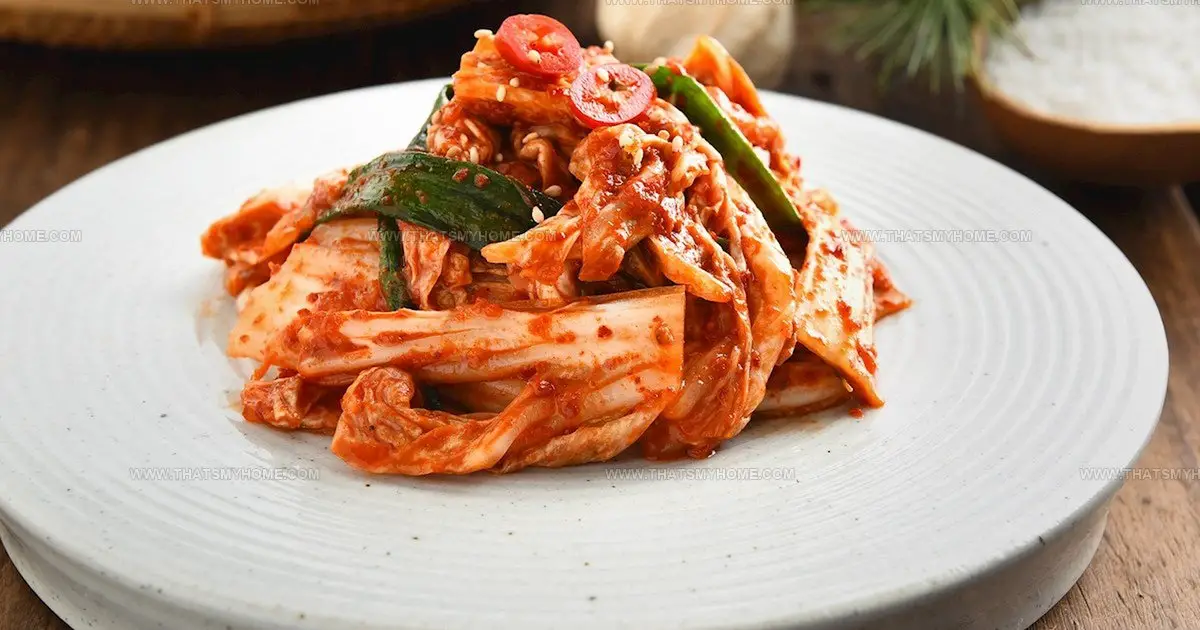
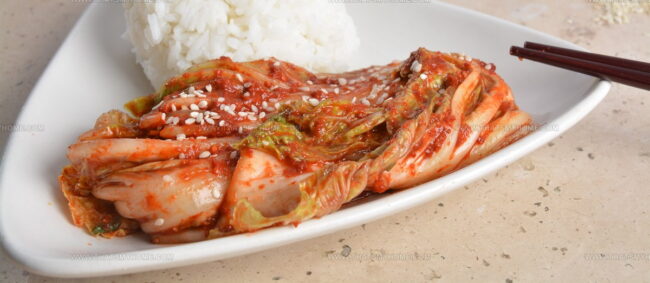
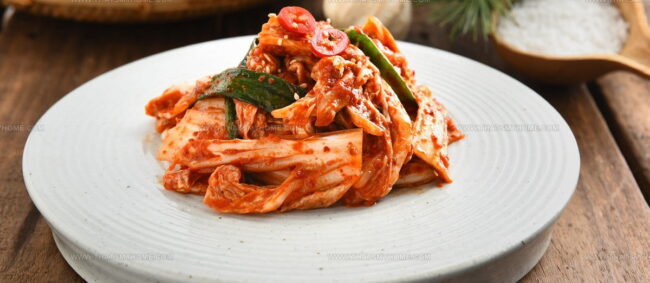
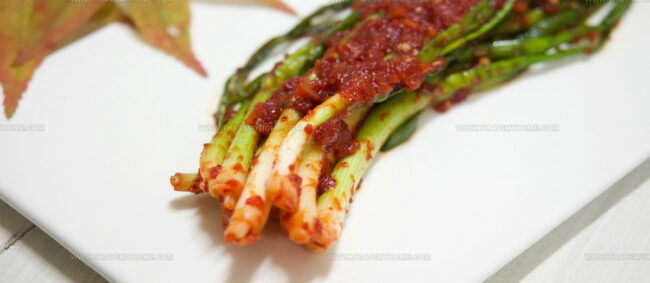
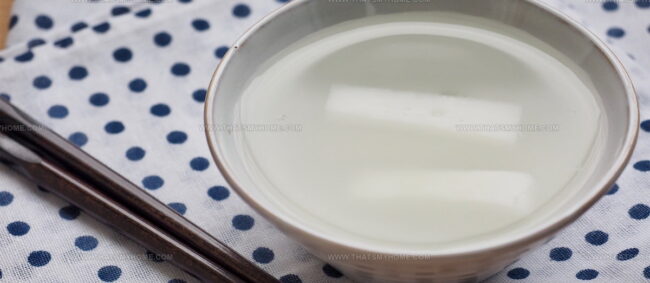
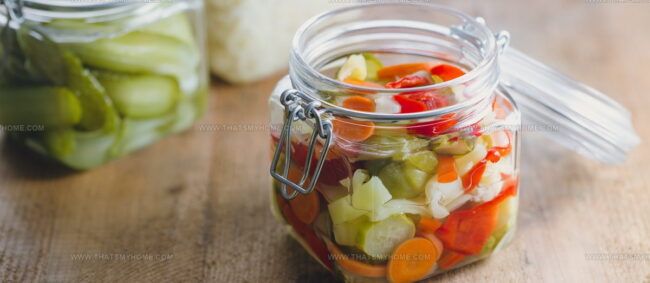
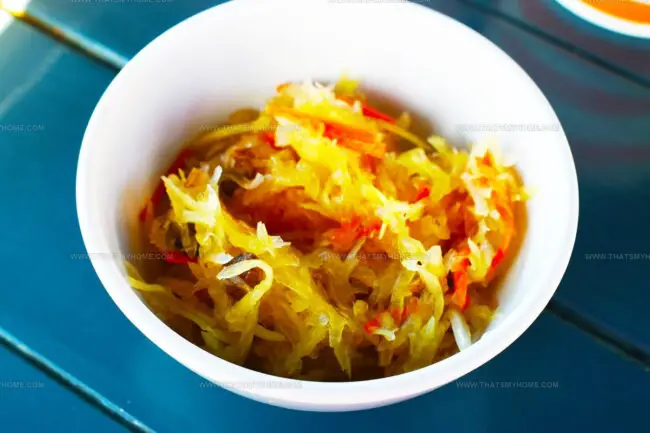
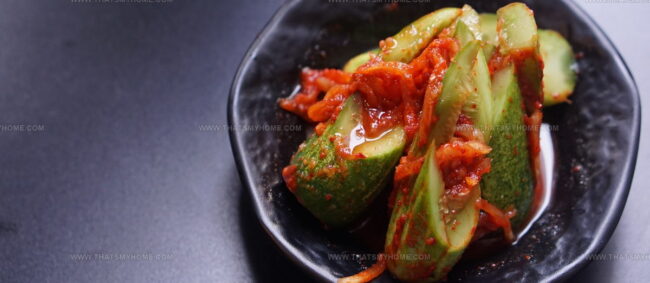
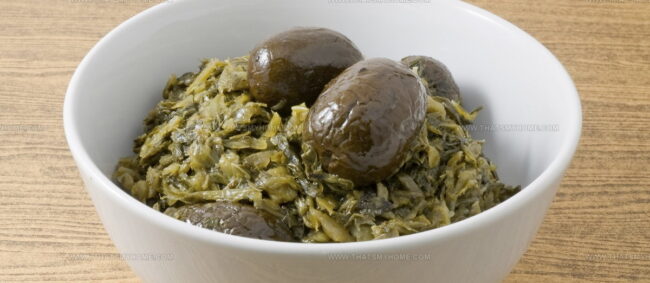
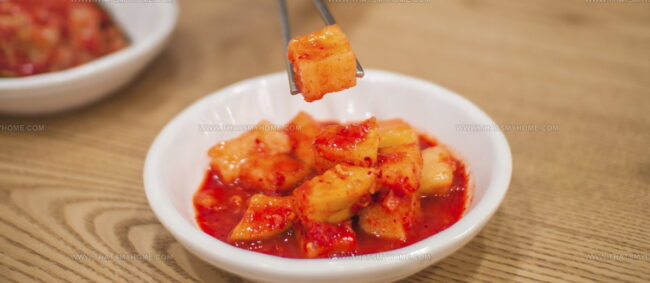
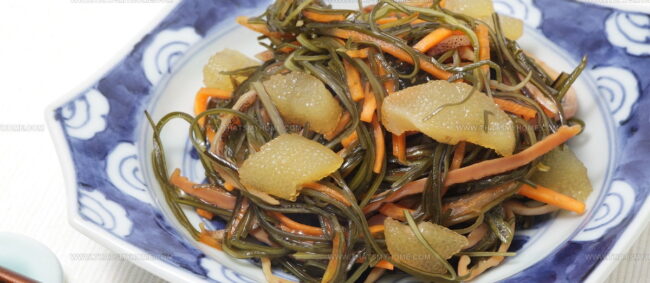
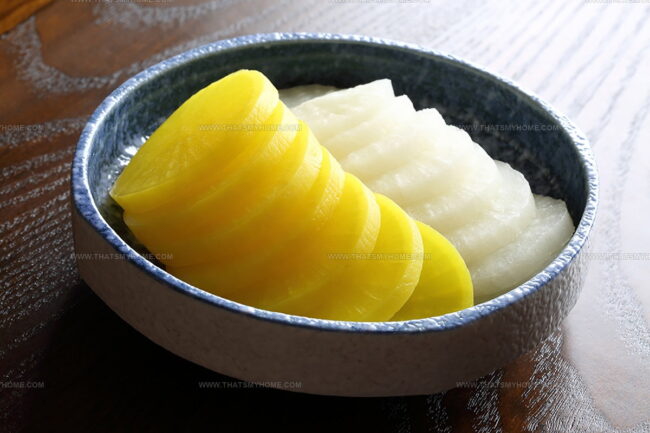
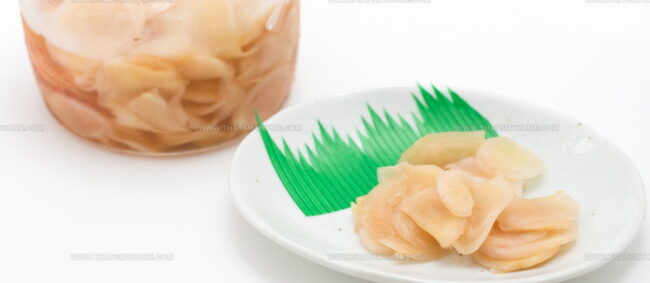
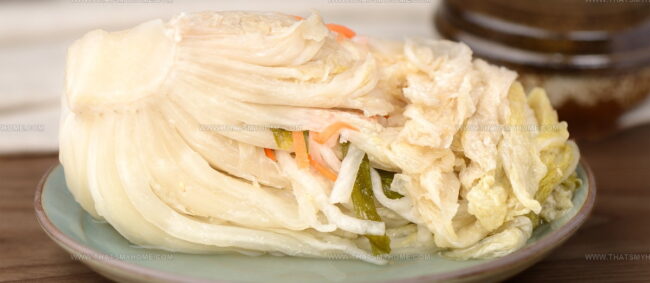
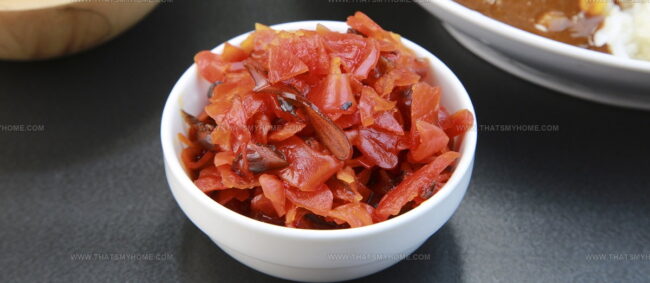
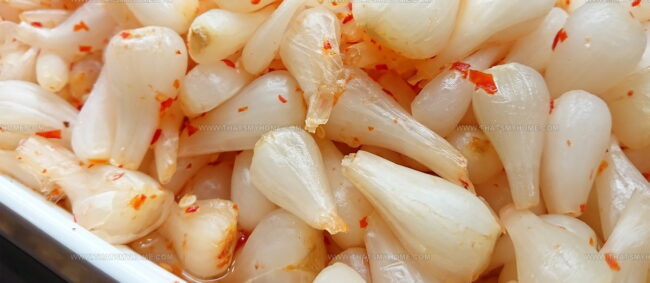
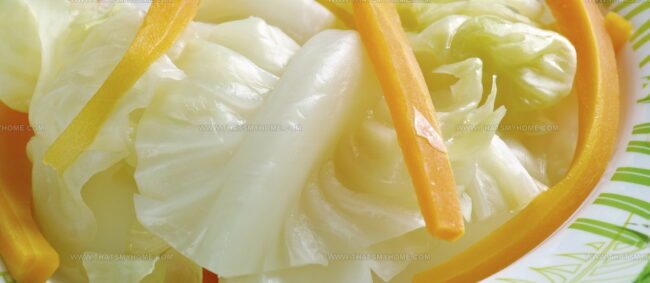
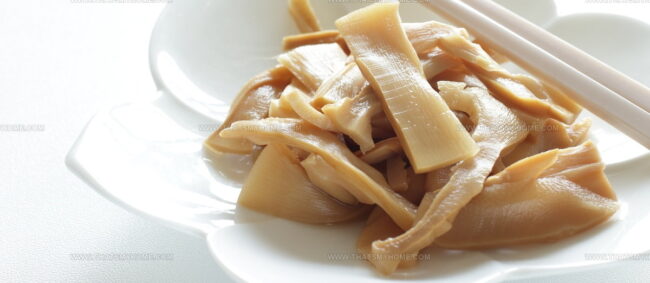
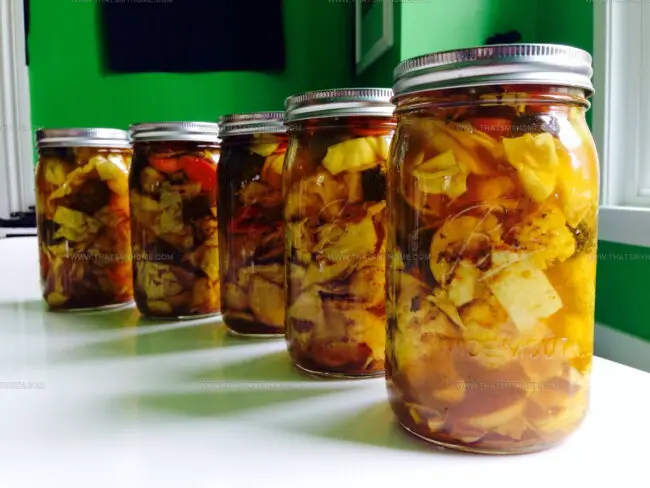
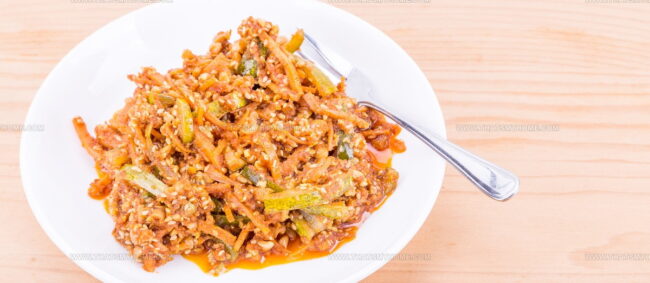
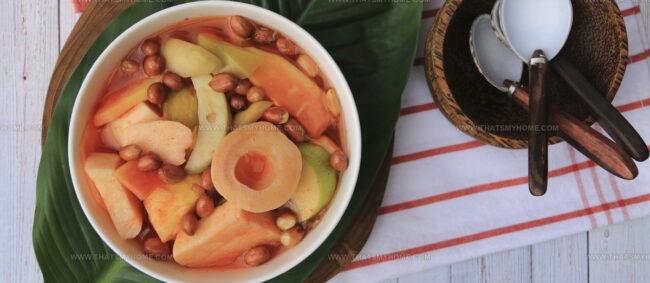
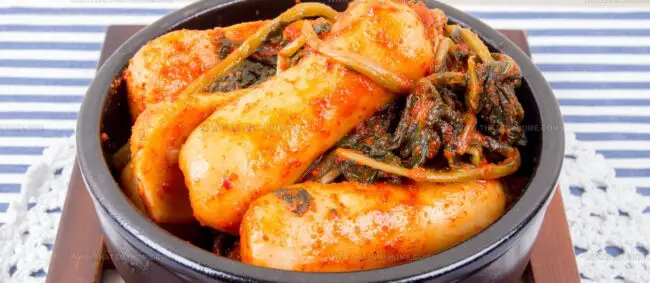
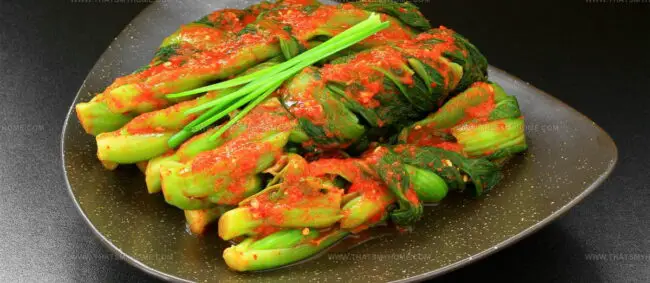
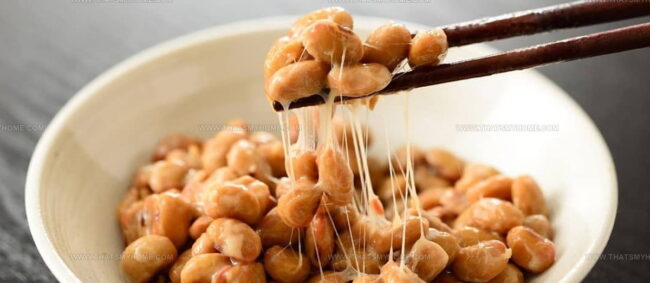
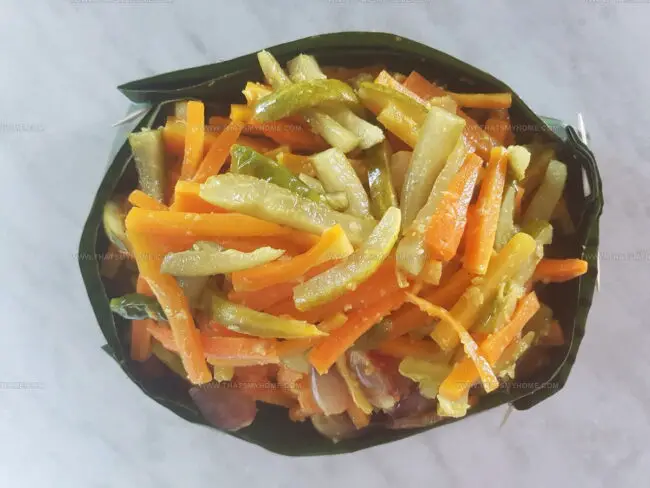
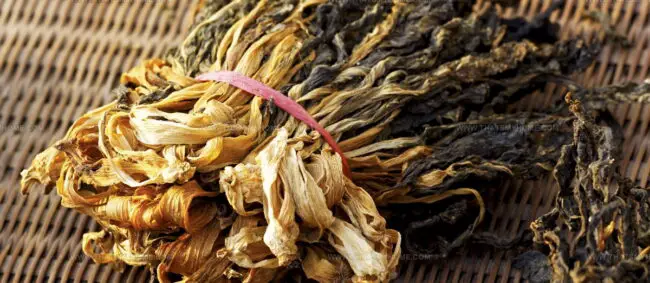
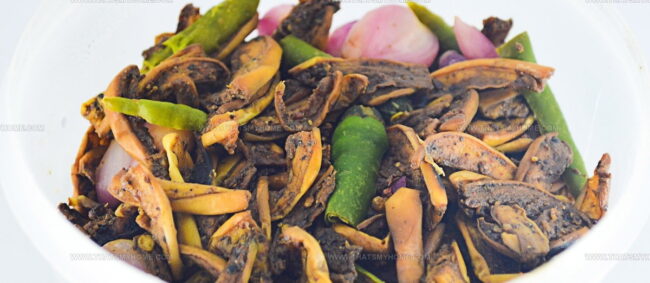
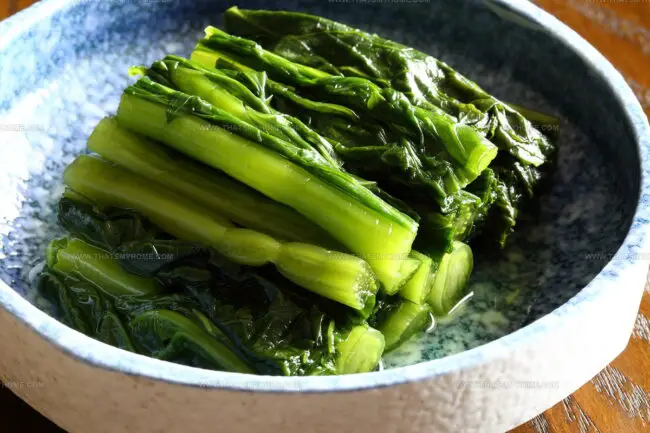
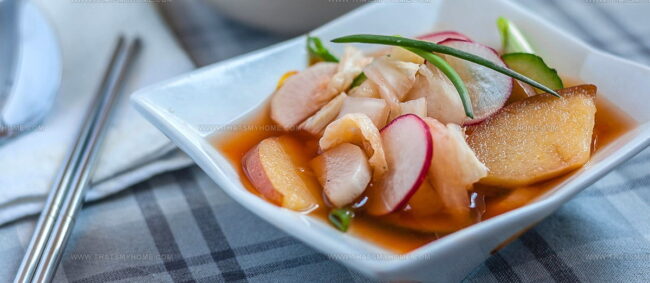
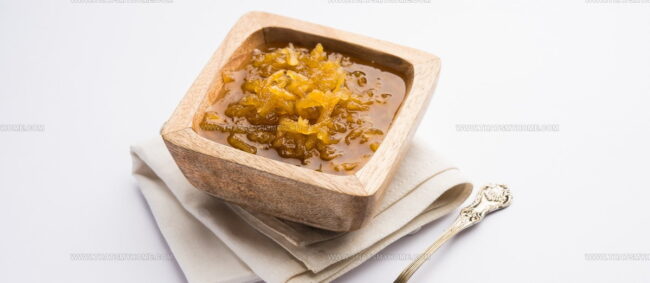
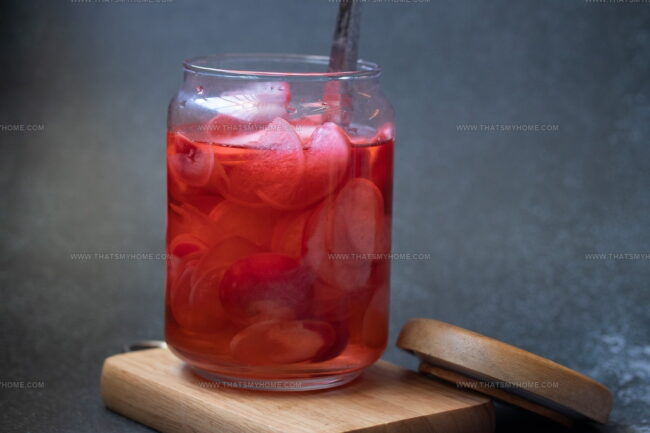
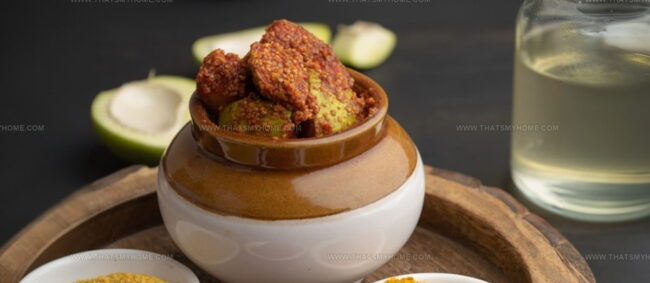
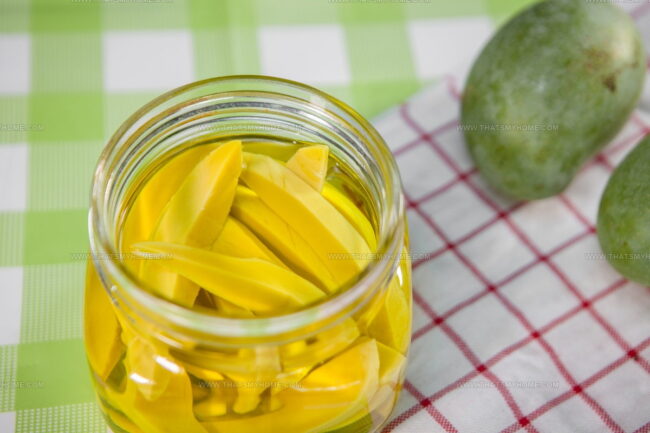
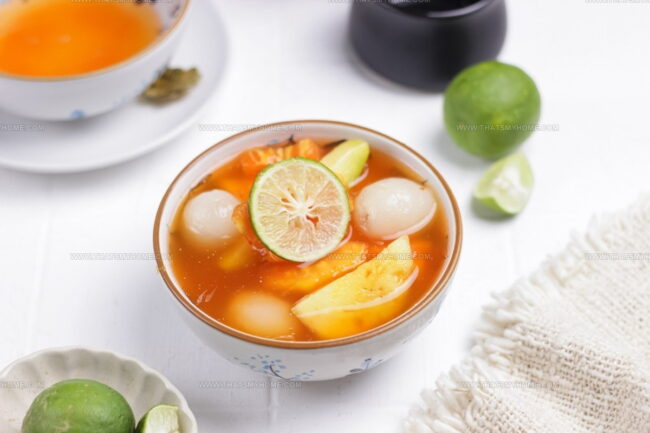
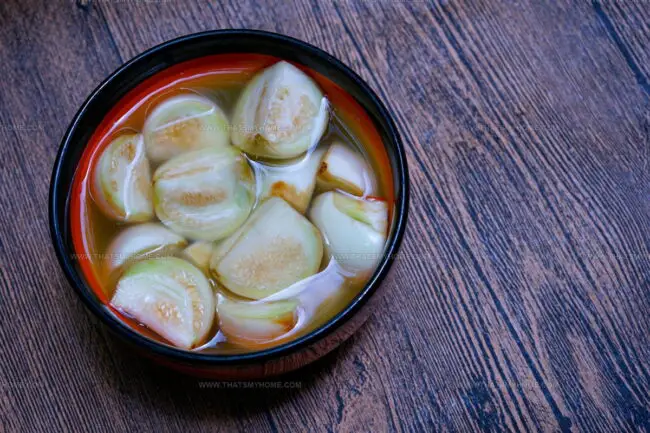
Mary Ellen
Founder, Pastry Chef & Recipe Developer
Expertise
Education
Savannah Technical College
Mary Ellen is the heart and soul of thatsmyhome.com. As the founder, pastry chef, and recipe developer, she refined her skills at Savannah Technical College with an Associate of Applied Science in Culinary Baking & Pastry Arts.
Mary blends classic techniques with modern twists to make artisanal breads, beautifully crafted pastries, and desserts full of unique flavor. Her passion is evident in every recipe, and she enjoys sharing her expertise through hands-on pastry workshops and insightful articles in local culinary magazines.